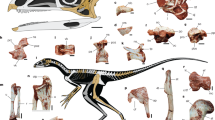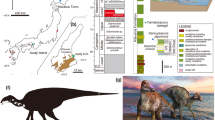Abstract
THE origin and early evolution of the great ape/human clade (Hominidae) is currently a subject of debate1–3. The controversy is fuelled by the fragmentary nature of the fossils which renders it difficult to determine clearly derived features that permit the recognition of fossil members of this clade. We report here the recent discovery of a facial skeleton and a temporal fragment with the petrosal bone of Dryopithecus laietanus, which provides a way out of an impasse. The lack of the fossa subarcuata is a great ape and human clade synapomorphy, and proves unequivocally that Dryopithecus belongs to this clade. The zygomatic possesses derived characters which reveal that Dryopithecus is related to the Ponginae and not to the African apes/humans, as recently suggested1. The remaining morphological features are plesiomorphic and thus provide a good model of a common ancestor of all Hominidae.
This is a preview of subscription content, access via your institution
Access options
Subscribe to this journal
Receive 51 print issues and online access
$199.00 per year
only $3.90 per issue
Buy this article
- Purchase on Springer Link
- Instant access to full article PDF
Prices may be subject to local taxes which are calculated during checkout
Similar content being viewed by others
References
Begun, D. Science 257, 1929–1933 (1992).
Dean, D. & Delson, E. Nature 359, 676–677 (1992).
Andrews, P. Nature 360, 641–646 (1992).
Lartet, E. CR Acad. Sci. P. 43, 219–223 (1856).
Napier, J. R. & Davis, P. R. in Fossil Mammals of Africa (British Museum Natural History) 16, 1–69 (1959).
Saban, R. Mem. Mus. Nat. d'Hist. Nat. 29, 1–378 (1965).
Pilbeam, D., Rose, M. D., Barry, J. & Shah, S. M. I. Nature 348, 237–239 (1990).
Simons, E. L. & Pilbean, D. R. Folia Primatol. 3, 81–152 (1965).
Aiello, L. & Dean, C. An introduction to Human Evolutionary Anatomy 1–596 (Academic, London, 1990).
Schwart, J. H. J. hum. Evol. 19, 591–605 (1990).
Andrews, P. & Cronin, J. E. Nature 308, 541–546 (1982).
Bonis, L., Bouvrain, G., Geraads, D. & Koufos, G. Nature 345, 712–714 (1990).
Groves, C. P. & Patterson, J. D. J. hum. Evol. 20, 167–183 (1991).
Author information
Authors and Affiliations
Rights and permissions
About this article
Cite this article
Solà, S., Köhler, M. Recent discoveries of Dryopithecus shed new light on evolution of great apes. Nature 365, 543–545 (1993). https://doi.org/10.1038/365543a0
Received:
Accepted:
Issue Date:
DOI: https://doi.org/10.1038/365543a0
This article is cited by
-
Late Miocene flying squirrels from Can Llobateres 1 (Vallès-Penedès Basin, Catalonia): systematics and palaeobiogeography
Palaeobiodiversity and Palaeoenvironments (2015)
-
New proconsuloid postcranials from the early Miocene of Kenya
Primates (2009)
-
The nature and evolution of intelligence in orangutans (Pongo pygmaeus)
Primates (1998)
-
Earliest known Old World monkey skull
Nature (1997)
Comments
By submitting a comment you agree to abide by our Terms and Community Guidelines. If you find something abusive or that does not comply with our terms or guidelines please flag it as inappropriate.



